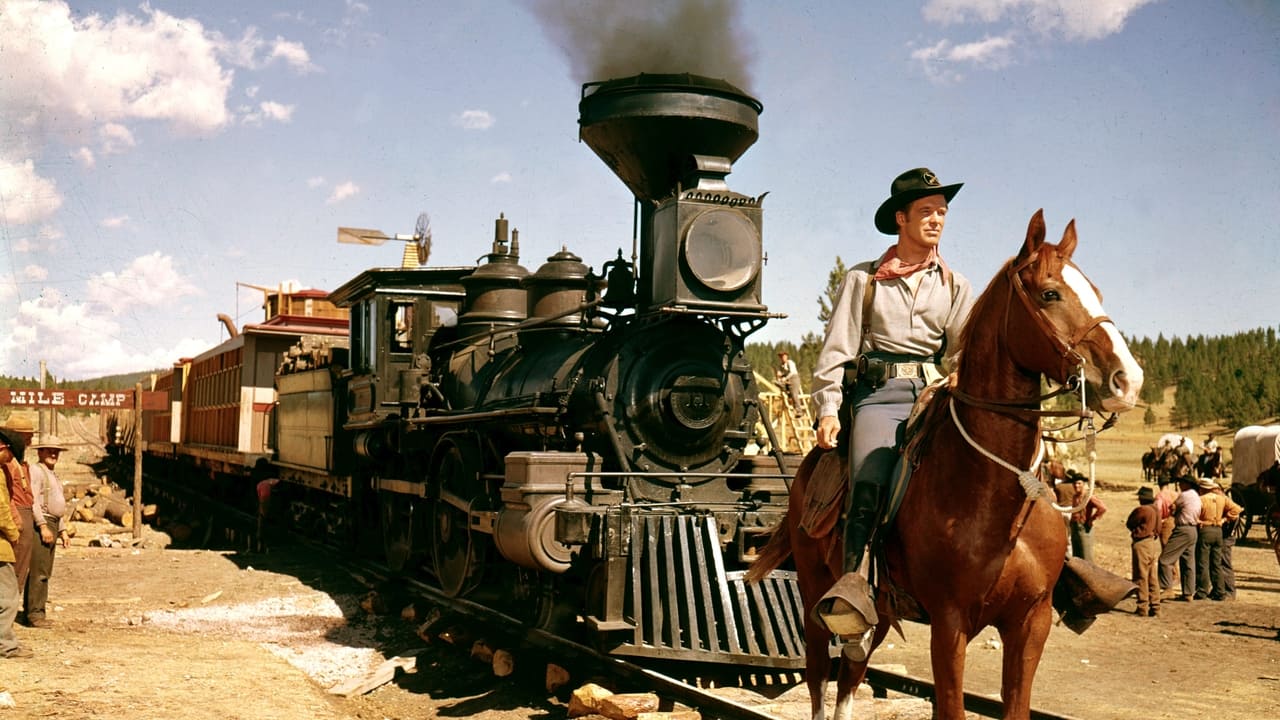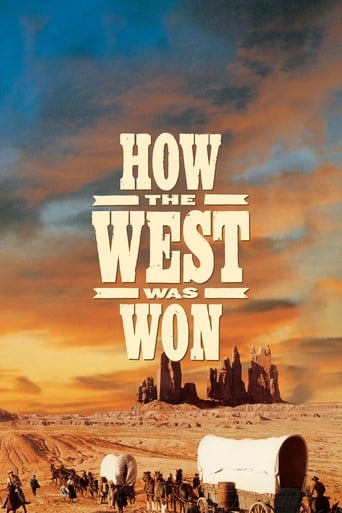

the audience applauded
... View MoreClever and entertaining enough to recommend even to members of the 1%
... View MoreA lot of perfectly good film show their cards early, establish a unique premise and let the audience explore a topic at a leisurely pace, without much in terms of surprise. this film is not one of those films.
... View MoreThere is, somehow, an interesting story here, as well as some good acting. There are also some good scenes
... View MoreAt Disney Parks, some of the Epcot (and other) films surpasses even Cinerama as they are 360 Degree "scope". Cinerama was the closest thing to that way back, decades ago. I saw "How the West Was Won" in it's 70mm wide-screen version on the big screen, not in Cinerama. Even on the current and much improved video version, the seam lines show up occasionally, as do color timing errors from the 3 film strips. However, it's a vast improvement over it's initial release on DVD disc format. Also, the "seams" were less prominent in true "Cinerama" projection. Is it a great movie? I like some of the segments far better than others. The action sequences are the best and the three involving the raging rapids, the tumbling pioneer wagon, and runaway train-buffalo stampede are thrilling. The Civil War (Directed by John Ford) is disappointing. Jimmy Stewart's misadventure with Walter Brennan is my least favorite segment for several reasons including bad writing and story. Historically, it's pretty inaccurate, as correctly mentioned by many other reviewers. Also, the present day ending is a big let-down. They should have shot something in a national park wilderness area. I still give it a "10" due to the tremendous effort and nostalgic value. Are there too many cameos? Maybe. They truly just don't make movies like this anymore!
... View MoreReally, all these rave reviews?! Did I watch the same movie?Apparently this was a grand spectacle at the time it was released. Twenty Four amazing actors and the filming of all the broad vistas were meant for the audience to ooh and ahh...But the story, oh the story is a mish mosh of plot points that in the end don't add up. Yes the writers and directors manage to pull the film full circle revolving mostly around one family.But ugh. Parts of the film were downright painful. Three to four different directors does not make for the most cohesive film!
... View MoreHOW THE WEST WAS WON was the 8th and final Cinerama film. Six travelogues preceded it, as well as MGM's only other feature in the process, THE WONDERFUL WORLD OF THE BROTHERS GRIMM (1962), released the year prior.MGM had taken a chance on the process to be able to satisfy the widescreen and stereophonic craze for epic films, but abandoned it due to its unsatisfactory performance next to its rival, Ultra Panavision 70, in which MGM produced MUTINY ON THE BOUNTY, also in 1962. The use of one camera, one strip of film and no curvature, and the ability to bring back close ups and medium shots sealed Cinerama's fate.This was a grand way to go out though. Five periods of the taming of the West: The River, The Plains, The Civil War, The Railroad, and The Law, and a roster of stars (13 leading, 10 supporting, plus a narrator). It had everything; story, cohesion, thrills – and all in enormous curved screen and Technicolor glory. At two hours and 44 minutes, it was the longest of the 8 Cinerama films and with its final shots (taken from or re-taken as a tribute to the America The Beautiful sequence ending THIS IS CINERAMA (the initial film in the process), it brought the Cinerama story full circle.Sad though that Cinerma cameras had a tendency to be covered with splotches of dirt in its aerial shots. This is rampant throughout the travelogues and here we can see it during Spencer Tracy's initial narration and at the end montage. How digital clean-up for Smilebox DVD presentation could have ignored these obvious defects is beyond my imagination.The image still needs some color correction and the images need sharpening, but the Smilebox DVD release is the best we have so far. The superlative score by Alfred Newman (one of his very best) is in turns stirring and sentimentally moving. Probably the most wrenching scene is Zeb's departure for the war, in which direction, score and the subdued performances of Carroll Baker and George Peppard bring tears.It is recommended to every lover of western films and to those in love with wide screen photography. The locations are gorgeous and always there to look at if one gets bored with the acting, direction or story line. All the actors do a creditable job, with the exception of Debbie Reynold's "old Lilith" at the end of the film. She did go on the next year to earn her only Oscar nom – for THE UNSINKABLE MOLLY BROWN (which used the same mansion exterior as her San Francisco house in WEST, by the way).It is interesting also to note upon reading these almost 150 reviews on the IMDb pages, that there seems to be no middle ground. Either reviewers loved the film or hated it. It's up to you to decide for yourself, but you must not miss it.
... View MoreReleased in 1962-63 and written by James Webb, "How the West was Won" is an epic Hollywood Western covering fifty years between 1839-1889 focusing on the Prescott family's move West and narrated by Spencer Tracy. This is a history lesson amped up with melodrama, romance, adventure, violence and song & dance.The film was done in Cinerama, which was a short-lived cinematic experiment involving three synchronized projectors and a huge curved screen. Only one other film utilized this process, "The Wonderful World of the Brothers Grimm," released the same year. Cinerama was invented so film could keep ahead of its growing rival, television, but it proved too expensive and cumbersome. Despite this, "How the West was Won" was a huge success at the box office.There were epic Westerns before and after, of course (1958's "The Big Country," 1960's "The Alamo," 1990's "Dances with Wolves" and 1994's "Wyatt Earp"). What separates "How the West was Won" is that it's split into five vignettes directed by three different directors, as follows:THE RIVERS (1839), directed by Henry Hathaway. This opening segment may turn off viewers with its eye-rolling "Disney Goes West" vibe and the corresponding corny dialogue, particularly the lightning fast romance that starts between Linus Rawlings (James Stewart) and Eve Prescott (Carroll Baker). But, if you can endure past such cringe-worthy moments, there's a sudden shift when the travelers run into a malevolent gang of river pirates (Walter Brennan, Lee Van Cleef and cutie Brigid Bazlen). The switch from quaint Disney-esque family-friendly material to nigh shocking violence is notable. One villain gets an ax wung into his back (!). The episode ends with a thrilling fatal rafting sequence. Karl Malden plays the patriarch while Debbie Reynolds plays the less-romantic sister. I must say that the producers knocked it out of the ballpark by featuring Baker, Reynolds and Bazlen in the female department; all three are breathtaking.THE PLAINS (1851), directed by Henry Hathaway. Lilith Prescott (Reynolds) ends up in St. Louis as a dance hall performer where she learns she's inherited a gold mine in California. A handsome gambler (Gregory Peck) catches wind and tags along on the wagon train, led by the great Robert Preston. Both guys want the babe, but only the latter seems sincere, which curiously doesn't interest Lilith. This segment is highlighted by Reynold's beauty and her entertaining song & dance sequences and a thrilling Cheyanne attack on the wagon train.THE CIVIL WAR (1861-1865), directed by John Ford. This segment starts at the Prescott homestead in Ohio where the son of Lilith, Zeb (George Peppard), decides to join the Civil War, after his dad did a couple of years earlier. This is the weakest of the vignettes because the scenes where Ulysses Grant (Harry Morgan) and General Sherman (John Wayne) hang out are obviously studio bound and, worse, the Shiloh battle sequence is almost non-existence. What a letdown! THE RAILROAD (1868), directed by George Mashall. After the war Lieutenant Zeb gets a gig in the U.S. Cavalry, trying to maintain peace with the Indians while befriending grizzled buffalo hunter Jethro Stuart (Henry Fonda), but Zeb becomes disillusioned when an arrogant railroad mogul (Richard Widmark) violates treaties with the Arapaho by building in their territories. The Natives retaliate by stampeding bison through the railroad camp and killing many. It's an impressive sequence.THE OUTLAWS (1889) directed by Henry Hathaway. Widowed, Lilith moves from San Francisco to her remaining asset, an Arizona ranch, inviting Zeb (Peppard) and his wife (Carolyn Jones) & kids to oversee it. But Marshal Zeb is threatened by a vengeful outlaw (Eli Wallach). Instead of waiting for the thug to strike, Zeb goes on the offensive with the help of reluctant Marshal Lou Ramsey (Lee J. Cobb). They hide out on a train with an unusually large gold shipment to ambush the outlaw and his gang. The exciting climax is impressive for its time and obviously influential in action-oriented cinema.As you can see, the movie isn't built around characters or a unifying plot, but rather a series of thinly-connected stories with a few characters carrying over to other segments (Baker, Reynolds, Peck, Peppard). It's a big film rather than a great one. But you have to respect its uniqueness and the fact that it pulls out all the stops to entertain on so many levels. The score by Alfred Newman, for instance, is one of the all-time best film compositions. While the movie sometimes disappoints—particularly the opening "Disney goes West" vibe and the truncated Civil War sequence—there's just too much good here to give it a bad grade. You just have to be willing to acclimate to its quirks and uniqueness. Needless to say, don't expect a conventional Western because "How the West was Won" is anything but.The film runs 164 minutes and was shot in Kentucky & Illinois in the East; and South Dakota, Utah, Arizona, California and Oregon in the West .GRADE: B
... View More